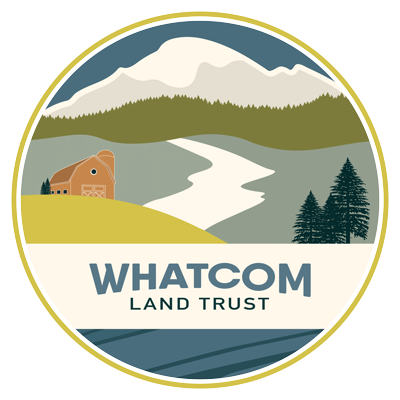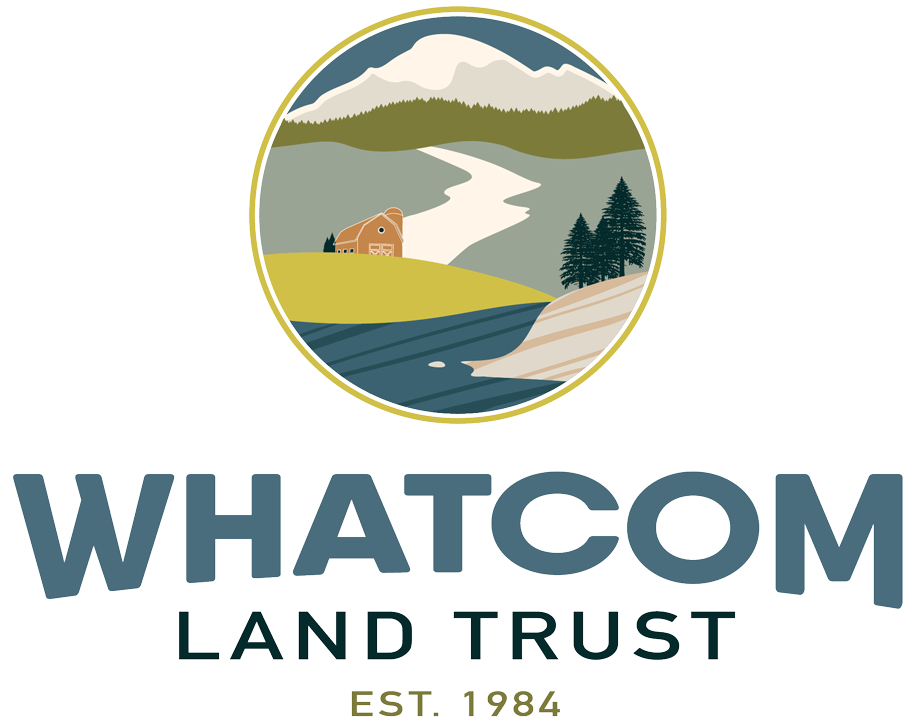During the past six months Whatcom Land Trust has shared its vision for Whatcom County in stories and interviews highlighting our work across seven geographical focus areas.
Lake Whatcom Watershed
In June, Whatcom Land Trust featured the Lake Whatcom Watershed as the first e-newsletter story of a seven-part series highlighting the seven priority zones of Whatcom Land Trust’s Conservation Plan update. The story shared the value of the watershed in promoting a healthy forest ecosystem to protect the drinking water source for more than 90,000 residents, and ways the Land Trust is working diligently with its partners to improve watershed health for future generations.
A large part of this effort has been the establishment of the Lake Whatcom Park, Whatcom County’s newest and 7th largest county park in the United States. In 2014, Whatcom Land Trust partnered with Whatcom County to facilitate the transfer of 8,844 additional acres in the Lake Whatcom watershed from the Washington State Department of Natural Resources (DNR) to Whatcom County. These lands are to be managed for long-term watershed protections while supporting low-impact recreation.
On June 3rd, National Trails Day, around 60 volunteers showed up at Lake Whatcom Park to kickoff construction on a new trail in the park. Now completed, ascending 1,000 switch-backed feet in 2.4 miles through a mix of forest types, the Chanterelle Trail offers visitors stunning views of Lake Whatcom and the Lookout Mountain Forest Preserve as they never have before. This trail is the second within the park with more in the works for the future. Whatcom Land Trust supports the County’s dual goals of low-impact recreation and watershed protections within Lake Whatcom Park.
Shorelines
Nearly everyone has a favorite spot along Whatcom County’s coastline. Our July Shorelines newsletter shared why we are committed to protecting shoreline habitat such as coastal forests, wetlands, feeder bluffs and estuaries for their collective positive impact on marine flora and fauna, on erosion prevention and in addressing sea level rise. The article focused on the more than 130 miles of iconic picturesque bluffs, rocky coves and treasure filled mudflats which line Whatcom County shorelines.
The feature story focused on the purchase of 11.5 acres at the mouth of California Creek where it empties into Drayton Harbor. In the works for years, the property has a very high conservation value due to its location, ecological makeup and future role as a public park along the shoreline. Funding and timing had delayed the process of purchasing this property, but with perseverance on June 30th the Land Trust acquired the land. Funding for this project was a joint effort from grants, a bridge loan from the Conservation Fun, a donation from the Blaine-Birch Bay Park and Recreation District #2 and donations from Whatcom Land Trust patrons.
In November Whatcom Land Trust received funding to pay down the loan by more than half, and a grant award from the Rose Foundation to jump-start restoration efforts beginning spring 2018. This includes removal of two barns, invasive plant removal and native plantings in partnership with our restoration partners.
Following the restoration and permanent protection through a conservation easement, Whatcom Land Trust will transfer the California Creek site over to the Blaine-Birch Bay Park and Recreation District #2 to own and manage as a public park. A November update from Ted Morris, Director of the Park District, shared his thanks to the Blaine-Birch Bay community for approving continued funding to assure the park’s future including a safe, off-road pedestrian and bicycle trail through the property that will eventually extend from Birch Bay State Park to Peace Arch. Whatcom Land Trust is committed to helping make the community’s dream a reality, and do our part to provide educational and stewardship opportunities as well as permanent protections in one of the most beautiful coastal areas in one of Whatcom County’s fastest growing communities.
North and Middle Forks of the Nooksack River
A combination of salmon, old growth forests and eagles; the North and Middle Forks of the Nooksack River make up part of the iconic landscape of the Pacific Northwest. Our August North and Middle Forks e-newsletter highlighted the ecological connectedness and wildness of this region through the lens of several Land Trust properties and County parks which welcome community members year-round. Our panel discussion with four long-time volunteer Land Trust naturalists showed through science and keen observation the challenges and opportunities facing the North and Middle Fork Nooksack today and in the future.
For example, flooding on the Middle Fork of the Nooksack in 2015 jeopardized fragile salmon habitat and threatened homes. One newsletter story explained how the Trust helped alleviate this situation. The goal was to create a win-win for both Middle Fork Nooksack wildlife habitat and property owners. The Trust was able to acquire approximately 12 acres of floodplain habitat as well as compensate six willing landowners impacted by this flooding event.
The properties which were acquired through this project had multiple structures which needed to be removed before the restoration work could begin. In September the Land Trust successfully removed those structures and began restoration on the properties. This project is an excellent example of the Whatcom Land Trust’s mission to preserve and protect wildlife habitat by securing interests in land and promoting land stewardship. The Trust created positive, lasting relationships with property owners and now this portion of the floodplain along the Middle Fork Nooksack will be protected forever.
In September we also hosted our ‘Welcome Back Salmon’ event at Wandering Waters Farm adjacent to our Maple Creek Reach property on the North Fork. It was a beautiful fall day to tour the property, espy returning salmon, learn from local naturalists about Whatcom Land Trust’s ongoing restoration to improve salmon habitat at Maple Creek Reach, and enjoy local bounty with friends and patrons. Save the date to join us in 2018,
Cascades to Chuckanuts I
Whatcom Land Trust’s September newsletter introduced readers to the Cascade to Chuckanuts (C2C) corridor – 350,000 acres of mostly undeveloped land and the only remaining place where the foothills of the Cascade Mountains still reach, relatively undisturbed, to the shores of the Salish Sea. This large corridor provides critical wildlife habitat and open space for native species to thrive. The C2C corridor encompasses a large portion of Whatcom County and represents all of the types of land and resources that the Trust works to protect. Among the many projects which Whatcom Land Trust has facilitated in the C2C corridor is the acquisition of the Edfro Creek property acquired in 2003. Whatcom Land Trust purchased the property to improve riparian habitat along the South Fork and also to improve the trail for better public access. Located along the South Fork of the Nooksack River, this property had long been used by hikers and backcountry horsemen and horsewomen. Over time and much use, the established trail on the land had been heavily deteriorated.
In July Whatcom Land Trust contracted with a Washington Conservation Corps (WCC) crew to spend two weeks improving the Edfro Creek trail. Carting gravel, building ‘turnpikes’ – reinforced elevated segments of trail, and rerouting the trail where necessary helped to improve this trail immensely. Previously known as ‘Thousand Puddles Trail’ this trail now provides a great opportunity for a relatively dry, mellow hike through the forest along the meandering South Fork, even on the sloppiest of days.
In November, the Trust signed a letter of intent with Weyerhaeuser to purchase 1,250 of riparian forest along 2.3 of Skookum Creek and another 150 acres of forested wetland adjacent to Skookum Creek at Duck Pond. As the purchase proceeds in 2018, this project has the potential to fulfill a long-term, 100-year vision that includes restoring a complex riparian old growth forest throughout the C2C Natural Area that will enhance and sustain ecological functions in perpetuity. More to come!
Cascades to Chuckanuts II
In part two of the Cascades to Chuckanuts the Trust focused on emerging opportunities on Stewart Mountain, the South Fork Nooksack watershed, and the role community forestry may play in helping to balance the needs of forestry, farming, floodplain mitigation and wildlife protection in the South Fork Nooksack Valley and the broader C2C region.
In November, the Nooksack Salmon Enhancement Association, in collaboration with Whatcom Land Trust, hosted a work party for volunteers to improve the Trust’s Riverstead property along the South Fork of the Nooksack River, remove invasive species and plant native species which will improve salmon habitat. In just a half a day, volunteers cleared and planted a large portion of the property near the river’s edge. Short term, efforts such as these complement in-stream restoration and wildlife habitat while long term, we’re creating an oldgrowth forest that will create multiple benefits for wildlife, farming, floodplain mitigation and forestry, as well as the people whose livelihoods depend on their coexistence in this region.
South Fork Nooksack River Valley and our Agricultural Lands
Last month we highlighted our gratitude for Whatcom County’s Farms, Fish and Forests newsletter. The South Fork Nooksack River Valley is an excellent example of where these three land uses coexist and are proving to complement each other. The Trust takes pride in promoting and protecting a longterm balance between farms, fish and forests and works together with land owners and local organizations to make more cooperation possible.
One tool Whatcom Land Trust uses to protect farms, farmers and agricultural lands is the Agriculture Purchase of Development Rights program (Ag PDR). This program, run by Whatcom County, allows interested land owners to sell specific development rights to ensure that their land retains its agricultural designation in perpetuity. Whatcom Land Trust contracts with the County to manage conservation easements on properties that participate in the Ag PDR program.
Whatcom Land Trust manages 18 easements totaling 905 acres and currently working with the County to fulfill our mutual goal to protect large tracts of productive farmland that are under significant threat of development. Farmer benefits from the program as their farmland becomes more valuable to successors and supports future ownership transitions, knowing their land will remain in farming forever and that the next generation will likewise benefit from the land. The community benefits through its support of a robust culture of land stewards who live on the land, work the land, protect productive, prime agricultural soils and resources.
We checked in with Chris Elder, Whatcom County Planner who promotes and administers the Ag PDF program for an update and to share his vision for the program. One of the many opportunities Chris is excited about is the Whatcom County Working Lands Conserving Watersheds partnership. Envisioned as a collaboration between multiple entities includes Whatcom County and Whatcom Land Trust, this project would build upon the success of the Ag PDR program and provide up to $2.5 million in matching funds to prioritize and accelerate acquisitions, protect and improve water quality, and address fish passage barriers. “I hope that the Ag PDR program can continue to support property owners to keep their land available for agriculture and protecting Whatcom County’s agricultural heritage and agricultural future,” said Chris. “Whatcom Land Trust continues to be a critical partner in the success of the Ag PDR program and the County looks forward to continuing this partnership into the future.”


